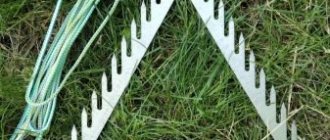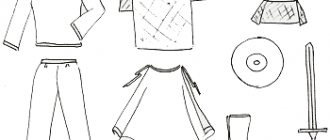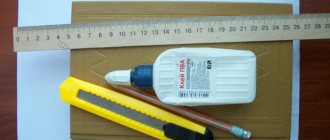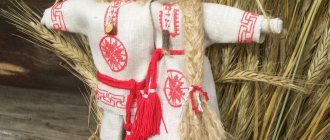To mow grass at the dacha or in villages, a hand scythe is still widely used. However, many people do not know how to maintain it in working order. But this is the most finely tuned tool among agricultural implements. And the main question when handling a scythe is how to maintain the sharpness of its blade for fruitful work. Today's topic is devoted to how to beat a braid for high-quality sharpening. However, first of all, let’s look at what kind of braids there are in principle, and what each of them is used for.
Three types of braids
The most common of the entire family of braids is the Lithuanian braid. Its name comes from ancient times, when they were cast from steel and then only forged. Litovkas were made on a par with swords, so the steel in them was of the same quality. Nowadays they are made by stamping from tool steels, so the Lithuanian braid holds the cutting edge well and sharpens well. They are available in several sizes to make it easier to mow grass in different conditions. For beginners, it is better to choose No. 7, it is easier to manage.
The pink salmon braid is used in places where there are a lot of hummocks and uneven areas. Its shape resembles a large sickle. It can also be easily recognized by its curved handle.
A serpan scythe, the blade of which is quite short compared to the others, is used for dry herbs.
Of all the varieties of braids, the Lithuanian braid has gained the most popularity. There are several sizes: No. 5, 6, 7, 8, 9 and 10. All of them are measured in decimeters, and the length of the blade varies from half a meter to a meter. When choosing such a braid, size is of great importance. The shorter the blade length, the easier it is to mow areas with uneven surfaces and in forests, between trees. The more flat and open the terrain, the longer the blade. Using the Lithuanian example, we will study in detail how to beat off a braid, and what tools we will need for this.
Also, the length of the braid was traditionally chosen based on the individual characteristics of a person: height, build and physical strength. After all, the larger the scythe, the heavier it is, and given that it receives strong resistance from the grass, you need to have good physical characteristics.
To make it convenient to harvest grass, the scythe tool must be very sharp. Before sharpening it must be beaten off. This is done so that the cutting edge becomes denser, thinner, and remains sharp longer. In order for the scythe to be a truly necessary tool that is convenient to work with, it must be beaten before sharpening. If you don’t do this, but simply sharpen it, such equipment will, at best, be enough for ten minutes of work, and then you will need to sharpen it again. Therefore, now we will study in detail how to properly cut a braid so that it cuts well and does not become dull for a long time.
Braids, hands and motor
Above, the author wrote a lot of useful information about setting up the braid, but I still want to add a little to his story.
My childhood passed in the village. During haymaking time, men from the collective farm were sent to mow by hand where mechanical mowers could not take the grass. And we boys always ran there. It was interesting for us. And when the most noble mower, who had seen the world of his grandfather, was assigned to rivet the scythes (and with constant work, each one had to be trimmed three to four times a day), then the real death began.
So that old man rivets and tells us in detail about every detail, what and how to do with it. After such lessons, even the most lazy and dull of us began to manage this matter. Oh, where would we find such teachers today... That grandfather mowed down - he danced like in ballet, he worked beautifully. After him, the meadow seemed to be shaved.
So, you need to start with the right choice of braid.
The most popular, that is, one might say, universal, is considered to be No. 6. This means that its blade length is 60 cm. Scythe No. 7 is also not bad, but it is more suitable for flat terrain, and it is harder to control. There are also No. 8 and 9, you can cut everything with them, but only physically very strong people can work with them. Numbers, by the way, are placed on the heels of the braid, next to the brands. Well, that means you’ve chosen your tool – it’s time to prepare the scythe for work.
Here’s the point: you need to start riveting the braid only from the middle, and carry it with your heels or toes, otherwise it will move in waves and then all is lost. And most importantly, you can’t hit the same place twice!
This means that we place the braid on the headstock with the plow down, mark the approximate center with chalk and rivet it in the direction of the spout with medium force hammer blows. Then again from the middle to the heel. With each pass we make the blows weaker and weaker, and the last one is so light. If the braid is clogged (that is, it has not been riveted for a long time), we go over it with a hammer 8-10 times.
A lot also depends on the choice of braid. The best tree for it is aspen or spruce, and its optimal length is 2 m. We attach a handle to it at the level of the navel. Ideally, you should not buy it in a store, but make it yourself, so that, as they say, it fits your hand. And if everything is done correctly, then mowing by hand is a pleasure.
A matter of technology
Working with this tool, I don’t get tired at all, and I don’t need to rivet it. And you can also forget about frequent sharpening with a whetstone. I mow with a hand scythe while there is dew (it wasn’t for nothing that they used to say: “Down with the dew and we’ll go home”), otherwise you won’t be mowing, but chopping. You can work with a lawn mower at any time. This is what we will discuss.
Before buying a lawn mower, you need to clearly understand what you need it for. For making hay, a unit with a power of 1.2-1.5 kW and an engine volume of at least 30 cubic meters is best suited. cm, otherwise it will be difficult to cut thick tall grass.
You can, of course, buy a more powerful scythe, but then the gas mileage will increase. Here it’s up to you to decide what is more convenient and profitable. In general, one worker with a lawn mower replaces almost three mowers with hand tools.
For a small area, a Chinese-made scythe is suitable - it is cheaper. I must say that if the manufacturing company is truly purely Chinese (you can immediately understand this from the name), then the quality of its products is quite normal. But if intensive use is planned, then it is better to save some money and buy a branded one in a company store.
And you need to be extremely careful and attentive with this matter, because counterfeits of big brands definitely do not shine with quality. I know of a case where a man bought a similar tool for crazy money, and a week later everything jammed. He took the unit to the warranty office, and only there they told him that he had purchased a fake. In general, nowadays they counterfeit so skillfully that anyone who does not know the nuances will take everything at face value.
For example, original products must have a serial number stamped on them. If he doesn't exist, beware.
READ MORE: Kurzat fungicide instructions for use principle of application rate
And I want to say about one important thing that many summer residents simply forget about or don’t pay attention to. When the season is over and you are putting away the lawn mower until next spring, be sure to remove all the fuel from the tank. There is no need to drain it (why pollute the earth?), just start the engine and let it run until it stops.
Tool preparation
To cut a braid efficiently, you need to have a straight headstock without dents from repeated use. Usually they are ground on machines. And, of course, you will need a smooth hammer, which also should not have a bumpy surface or bevels from impacts. A high-quality tool is convenient to use because everything is visible, and the results of impacts are predictable. If the hammer or headstock is uneven, then during impacts, unwanted dents may appear, which, if not removed in a timely manner, can damage the blade.
Varieties
There are many varieties of braids today. On farms, the following 3 types are distinguished.
- Bagpipe or pink salmon. When you mow with it, you have to bend too much, since the shaft has a crooked shape. The advantage of the tool is its long, curved blade, which makes it easy to cut grass in areas overgrown with bushes or with hummocks.
- Lithuania is in greatest demand. This tool can be used with a completely straight back. The braid of this species is long, and the blade of the knife can be of very different lengths. It is often said about this braid that it is a garden braid.
- The serpanka is a fusion of a scythe and a sickle. The main advantage is that it is lightweight. This is due to the small dimensions of the tool.
There are also different types of braids based on the principle of their operation and appearance.
- Manual, which makes you work not only your hands, but also other muscles.
- A mechanical or lawn mower looks like a unit with blades on wheels. With this unit, one knife remains stationary, and the rest move, working on the principle of scissors.
- The spindle unit consists of spindle knives driven by rotating wheels. Divided into 2 types. The disadvantage of such devices is the need to constantly adjust the speed. Moreover, these units are not suitable for large areas.
- contact, in which the blades of the cutting elements intersect;
- non-contact, in which the blades are located at a certain distance, and mowing occurs by capturing and feeding the grass to the knives.
- Folding is easy to transport and convenient to store. The small size of the scythe due to the shortened shaft is considered by many to be convenient. Some models of this type are produced with a handle, and some with a rubberized attachment on the knife. Such a small scythe is suitable for compact areas and is completely unsuitable for haymaking.
- The mini scythe is shaped like a knife and resembles a sickle. However, its metal handle is more powerful, straight, and its length does not exceed 1 meter. The cutting element reaches a maximum length of 35 cm. Suitable if the area of the grass to be mowed is small.
Where to get or what to make a grandmother from
These simple devices are sold in specialized stores. Of course, it’s easier to find them online than to find a department for mowers in the city. If you couldn’t find a headstock, you can make it yourself. After all, by and large, it’s just a piece of steel. Large files and springs are ideal; an old hammer can also be secured and used. It is very important to choose a material from sufficiently hard steel. Because if it is very soft, then the hardened scythe will crush it when struck. And the resulting irregularities can significantly damage the cutting edge.
How to mow?
The braid is taken with the left hand by the braid above the handle, and with the right hand - the handle itself, grabbing it from above. Place the right leg in front, the left leg behind, turn the body slightly to the left, bend slightly - and begin to mow in a circular motion from right to left.
The scythe may encounter a stone or bump, causing part of the blade to bend to the side and become dull. To correct a damaged blade, the mower must always carry with him a spatula (Fig. 31, d) - a birch bark case 1, attached to the belt with a strap 2. The case contains a sharpening stone 3 and a smooth steel rod 4. In order to bring the blade into order, stick the end of the braid into the ground, wipe the knife with a bunch of grass, take a steel rod, press it against the damaged area of the blade and straighten it so that it takes a normal position. After this, the blade is sharpened with a whetstone.
If a good scythe knife is chosen, it is correctly (as described above) adjusted to the mower, skillfully sharpened and beaten, then such a scythe is easy to work with.
Source: Small mechanization in household plots and farms. Ed. I.P. Oil. 1996
We begin the process of beating the braid
So, the headstock is driven into the deck, and the blade itself is removed from the handle. This will make it more convenient to work. If you don’t want to remove it, then you need to provide a stand for the handle, with the help of which a regular scythe can be placed in a convenient position for beating.
Before use, the blade is immersed in water for half an hour, where it becomes darker. This is necessary in order to see the edge that is formed after the blows are made. It will be much lighter than the rest of the surface.
The scythe is placed on the headstock with the cutting edge facing you, after which they begin to hit it from the heel, without applying much force and as if pulling the steel in their direction. The hammer must be brought in when hitting from the side of the scythe, and the movements must be completed as if pulling it towards you. Thus, the metal begins to be gradually pulled in the required direction. Don't rush and speed up the process with stronger blows. This can result in an uneven edge that can cause waves, or the blade becomes deformed altogether. In this case, the braid will be damaged. You should do everything slowly, because beating a braid with a hammer is a rather labor-intensive process that requires gradual and patient progress.
In order for the cutting edge to be forged smoothly, it is necessary to shift with each blow, moving evenly from the heel to the end of the blade. After the first flattening, the entire edge should remain smooth, without wavy bends. If somewhere you can see that there are dark places left, it means that this place was not forged properly. Very carefully, using even weaker blows than usual, you need to fix everything so that the surface becomes uniform. Then they beat the other side in the same way. After this, they look: if the edge is not riveted enough, they begin to make the same movements again, from the heel to the end of the blade, until the desired effect is achieved. And thus, by taking turns riveting first one side, then the other, the blade is brought to the desired thickness. Over time, when more experience appears, the question of how to break off a scythe will not be so pressing. Everything will be done in fewer approaches and less time.
Breaking a braid, step-by-step instructions
What does it mean to break a braid? This means that its cutting edge must be flattened. It will become thinner and, accordingly, sharper. As a rule, a special place is equipped for beating the braid. The process is difficult for a beginner, but everything in our lives happens for the first time. And having gained a little experience, the procedure will not be laborious for you.
Required tools and materials
The result of mowing directly depends on the sharpness of the scythe. To beat a braid at home with a hammer, you will need the following tools:
- The most important element is the hammer. But you need to pay attention to his condition. Its working surface must be perfectly flat. If there are nicks, gouges or other defects, they must be removed. A grinding machine will help. Otherwise, the beating result will be of poor quality.
- Another equally important tool is the headstock. You can buy it in a store or make it yourself. The headstock is often made from a file because it has a high metal hardness. But it also happens that over time, notches and depressions appear. They need to be removed.
- A convenient object for support is required. Typically, stump is used for these purposes. The headstock is inserted into it. But you can also use a vice. This is optional.
- Of course, you will need the scythe itself and a container of water.
The scythe and the toolkit itself.
Preparation of the workplace
At the very beginning of work, it is recommended to place the scythe blade in water. The metal will acquire a dark coating, which will make it easier to monitor the beating process. Then the headstock is installed in the stump. It must sit firmly and not dangle, otherwise it is easy to damage the scythe knife when beating. Or get injured yourself.
Prepare a comfortable place for the master to sit, choose a comfortable bench. The process is quite long and painstaking; squatting or standing half-bent will be extremely uncomfortable. If a person is right-handed, then the headstock should be positioned in such a way that the main part of the braid is located on the right knee.
We beat off the scythe
During the beating process, the most important thing is not to rush. There is a high probability of ruining the braid. Due to improper beating, the braid may break during operation:
- The kick starts from the heel. Place the braid comfortably on your knee and the beating part on your headstock. Hold the knife strictly perpendicular to the headstock, do not let the edges droop. Otherwise, the result will be a wavy blade.
- The blows to the knife should be applied in duplicate, while pulling the hammer towards you. Gradually we move the blade along the plane relative to the headstock.
- It is important not to skip uncut areas. During operation, the blade should be smooth; if this effect does not exist, it means that in some place the blows were weaker and the metal was not flattened as desired.
- When small cracks form on the edges of the blade, this means that this place has already been well beaten. The minimum thickness of the metal has been reached, and this place should not be touched anymore. After beating off one side, the braid is turned over symmetrically to the other side.
- During the beating process, the hammer should be moistened with water. This way, at the point of impact, the dark layer will be cleaned off from the scythe and the place where it was hit will be visible. You should monitor the force of the blow; it is better to make several weak ones than one powerful one.
Watch the plane of the knife, strike strictly parallel to the blade. The maximum blade can be repelled by 3 mm, but 1.5-2.5 mm is considered the most popular. If you hit it harder, the knife may break.
The process of cutting a braid.
Application of a slope breaker
It should be noted that the most difficult thing to cut is a new braid that has not gone through this process before. The metal on it will be as thick as possible.
But for beginners and those people who often engage in hammering, a special tool has been invented - a slanting hammer. It can be purchased at the store.
When using such a tool, beating becomes easier and anyone can do it. You no longer need to monitor the width and constantly aim the blade at the headstock. The blade is installed in the oblique hammer, and it rests against a special support.
This achieves the optimal gap for flattening the metal. The master can only strike the top of the instrument and ensure that the beating proceeds evenly. Moving the blade along the plane in the slope.
Work as a slant breaker.
Sharpening the scythe
The braid is sharpened in two stages. The first is scraping, the second is editing. Scraping is necessary to make the surface smooth and remove excess metal. A scraper is used for this. It is made from a triangular file, from which the rough surface is ground off on a machine, thus making its edges sharp. The Lithuanian scythe is sharpened only on one side - the one that is on top during work. To scrape, you need to hold the scythe at the heel and run the scraper along the blade along to the very edge. This needs to be done several times, while creating a constant sharpening angle. When burrs begin to appear on some parts of the cutting edge, this means that scraping is finished and it’s time to start straightening. To do this, use an emery block. It is used in the same way as with a scraper, trying to maintain the same sharpening angle. It is very important that the angle is the same as when scraping, because by changing it a little, you can, on the contrary, dull the braid.
You can make a braid with your own hands
The best material is young spruce. It is dried in a vertical position in the shade. The wedge is made from durable dry wood (acacia or oak).
The handle can be made movable (Fig. 5). To do this, use a freshly cut willow or bird cherry branch. Then it is bent along a circular braid and secured with twine. At the bottom of the braid, a cut is made to install the heel of the knife.
Its slope is chosen in this way: place the mower on a level surface in the mowing position with a pre-installed knife. The blade lift should be 10-20 mm. After making the bevel, apply the heel of the knife and mark where the tenon should be recessed (Fig. 6 and 7).
Gripping the scythe is important. It depends on the hardness, density and juiciness of the grass and is installed using a cord (Fig. 8). For softer grasses, a positive grip is set between 0 and 20 mm. For hard grasses, the grip is set to negative. In this case, you can mow with less effort and with better quality.
Choosing a braid
We have fully studied how a braid is beaten and then sharpened, now it’s worth telling how this tool is chosen. Now that there are many varieties of braids and their manufacturers, low-quality products are very common. Moreover, braids - even in Soviet times, when everything was only according to GOST standards, it was difficult to find high-quality ones. Usually, out of three, one was good, and the rest were made of unsuitable steel. Now it doesn’t matter how much a braid costs; even among very expensive models there are often bad ones. In general, it is better to check this delicate instrument yourself before purchasing.
How to cut a braid correctly at home
It happens that a person with little experience in agriculture tries to mow the grass with a hand scythe. But he practically fails to do this. The grass is partially mowed, and the rest is simply crushed. And most importantly, sharpening the scythe does not give the required result.
It's all about the thickness of the cutting blade. The thinner it is, the easier and simpler it is to mow the grass. The knife should be brought to a razor sharpness. And for this you need to break the braid. During the beating process, the metal becomes thinner and stronger, this is a kind of cold hardening of steel.
Traditional methods for checking the quality of braids
The first method: you need to take a piece of window glass and run it along the blade. If the glass is not going well, you get the feeling that it is clinging to something, which means you shouldn’t take such a scythe. Her steel is soft and will be more trouble than good. There are even such specimens that when you conduct this experiment, metal shavings are removed from their surface. Naturally, with such a tool, the question of how to properly cut off a braid will not even arise due to its unsuitability. Ideally, the glass should pass smoothly along the blade without leaving the slightest mark on it. The second method: you need to place a match across the tip of the scythe blade, balancing it, and gently push it from one side. If the match turns, then it is a quality braid.
There are more stringent methods of verification. You need to take a metal nail and run it across the blade. If it remains without visible defects, and even better, shavings are removed from the nail, then this is a 100% high-quality tool that will last for decades. Of course, durability also depends on how the scythe is beaten when using it.
You can hit the tree with the butt of the scythe. If the sound is high and extended, the braid is good. You can also rest the end of it against a board on the floor and press from above. If the steel bends evenly and returns to its previous position when released, such a braid is worth buying.
Step Three: Using Oblique Breaks to Break the Spit
For those who are engaged in mass cutting of scythes, it will be useful to have such a device as a scythe breaker.
- When using such a device, beating off a braid becomes very simple and anyone can do it.
- Here you no longer need to monitor the width and constantly aim the scythe blade at the headstock.
- When the blade is installed in the bias breaker, it rests against a special support and thereby establishes the optimal clearance for the striker.
- The master only needs to strike the headstock with a hammer and ensure that the beating of the braid proceeds more or less evenly.
- The most difficult thing to beat is a scythe that has never been beaten before, since its metal will be as thick as possible.
Kosootboy KS - 1: 1 - striker; 2, 4 — screws; 3 - body; 5 - grandma; 6 - working surface of the headstock; 7 — groove; 8 - collar; 9 — shank; 10 — scythe knife; 11 — support
Breaking the braid using the KS - 1: 1 - Support (block);
2 — scythe knife; 3 — slanting; 4 - hammer That's all. After beating, the blade needs to be sharpened and after that you can start mowing the grass. If everything is done correctly, then during work you will immediately feel that the scythe is cutting the grass, and not tearing it and crushing it, as it was before. At the same time, mowing will be quite easy, and the grass will be mowed down to the very roots; of course, here a lot depends on the mower.
Non-Russian braid
There are no less problems with the handle of a scythe purchased in stores. The Artinsky assortment, for example, includes metal braids; they are good because they are attached to the canvas with a death grip. But why short? When mowing, the length of the mow is clearly not enough for the left hand. It turns out that it was made not for the Russian style of mowing, but for the European one, in which the scythe is held by two handles, and the left hand goes behind the back when passing the scythe. But why are they sold everywhere here?
– This is where the peculiarity of trade comes into play. The plant offers three options for mowing, including a long one, to suit the habit of mowing in Russia. But the long one is a little more expensive, and wholesalers profit from rubles by taking whatever is cheaper for sale,” says Alexander Shatokhin.
There is only one choice - to order a normal braid on the plant’s website yourself, without intermediaries. It would be even better if it were possible to order a whole braid, completely ready for use. Maybe then we would have more people willing to mow with a hand scythe. By the way, according to Alexander Shatokhin, in Europe and the States there is a return to the braid. It’s not for nothing that Artinsky braids are actively going abroad; they recently appeared even in Alaska and the distant island of Tasmania.











